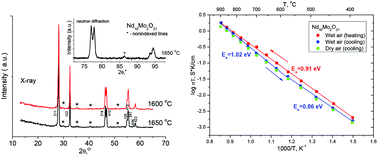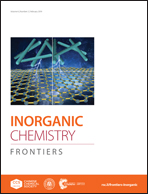Structure and conductivity of Nd6MoO12-based potential electron–proton conductors under dry and wet redox conditions†
Abstract
Nominal compositions Nd6MoO12 (3 : 1) and Nd10Mo2O21 (5 : 2) were prepared by high-temperature synthesis in air from a mechanically activated mixture of Nd2O3 and MoO3. Phase-pure Nd6MoO12−δ and Nd6MoO12−α have been obtained at 1600 and 1650 °C, respectively. They are both slightly rhombohedrally distorted derivatives from the cubic fluorite structure. Nd10Mo2O21 with a lower content of Nd2O3 was shown to be a more complex phase based on the rhombohedral phase (R![[3 with combining macron]](https://www.rsc.org/images/entities/char_0033_0304.gif) ) in the 1600–1650 °C temperature range. As a result of the formation of a more complex rhombohedral phase, the conductivity of Nd10Mo2O21 changes dramatically in comparison with Nd6MoO12−δ. In wet air Nd6MoO12−δ is a p-type electronic conductor, whereas proton conductivity dominates in Nd10Mo2O21 over the entire temperature range studied. The electrical conductivity dependence of Nd6MoO12−δ on the oxygen partial pressure shows a V-type behaviour typical of a transition from a p-type to n-type conductivity mechanism at 800 ≤ T ≤ 1000 °C. There is no p-type conductivity contribution in Nd10Mo2O21 in the same temperature range. The prevalence of electronic conductivity in the samples with nominal composition Nd6MoO12 in a wide temperature range is due to the fact that Nd and Mo in the fluorite materials are readily reduced. Predominantly Nd3+ and Mo6+ forms exist in more complex rhombohedral phase Nd10Mo2O21 and it has proton conductivity ∼8.5 × 10−3 S cm−1 at 800 °C. Thus, the loss of dimensional stability is more characteristic of fluorites and rhombohedral phases with small rhombohedral distortion (Nd5.4Zr0.6MoO12.3, Nd6MoO12−δ) than more complex rhombohedral phases based on (R
) in the 1600–1650 °C temperature range. As a result of the formation of a more complex rhombohedral phase, the conductivity of Nd10Mo2O21 changes dramatically in comparison with Nd6MoO12−δ. In wet air Nd6MoO12−δ is a p-type electronic conductor, whereas proton conductivity dominates in Nd10Mo2O21 over the entire temperature range studied. The electrical conductivity dependence of Nd6MoO12−δ on the oxygen partial pressure shows a V-type behaviour typical of a transition from a p-type to n-type conductivity mechanism at 800 ≤ T ≤ 1000 °C. There is no p-type conductivity contribution in Nd10Mo2O21 in the same temperature range. The prevalence of electronic conductivity in the samples with nominal composition Nd6MoO12 in a wide temperature range is due to the fact that Nd and Mo in the fluorite materials are readily reduced. Predominantly Nd3+ and Mo6+ forms exist in more complex rhombohedral phase Nd10Mo2O21 and it has proton conductivity ∼8.5 × 10−3 S cm−1 at 800 °C. Thus, the loss of dimensional stability is more characteristic of fluorites and rhombohedral phases with small rhombohedral distortion (Nd5.4Zr0.6MoO12.3, Nd6MoO12−δ) than more complex rhombohedral phases based on (R![[3 with combining macron]](https://www.rsc.org/images/entities/char_0033_0304.gif) ) (Nd10Mo2O21). A comparative high-temperature in situ neutron diffraction study under high vacuum of rhombohedral Nd6MoO12−δ and cubic fluorite Nd5.4Zr0.6MoO12.3 showed that the former transforms to the high-temperature cubic fluorite type above ∼1140 °C while the latter retains its cubic structure in the studied range up to 1350 °C.
) (Nd10Mo2O21). A comparative high-temperature in situ neutron diffraction study under high vacuum of rhombohedral Nd6MoO12−δ and cubic fluorite Nd5.4Zr0.6MoO12.3 showed that the former transforms to the high-temperature cubic fluorite type above ∼1140 °C while the latter retains its cubic structure in the studied range up to 1350 °C.



 Please wait while we load your content...
Please wait while we load your content...